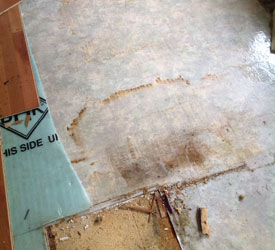Here below yow will discover a lot of professional additional info about Preventing Water Damage in the Bathroom.

The restroom is extremely susceptible for moist accumulation and possible water damages because of the regular use of water in it. This article offers simple inspection strategies to aid identifying water damages dangers.
The regular use water in the shower room makes it incredibly susceptible for damp accumulation and potential water damage. By evaluating it on a regular basis, you can decrease water relevant damages.
The following collection of examinations is simple to do as well as should be done once in every 3 months in order to maintain your shower room in good shape and to stop possible water problems caused by the bathtub, the shower, pipeline joints as well as plumbing, sinks, cupboards, and the commode
Do not disregard carrying out these inspections and also be complete while performing them. Keep in mind that these straightforward assessments can save you a great deal of cash by offering early indicators for water damages
Tub and Shower
The shower as well as bathtub need unique attention and also maintenance. Examine the tiles and also replace if fractured. Ensure that there is no missing out on grout in between the tiles. Evaluate and change cracked caulking at joints where the wall surfaces meet the floor or the bath tub. Blocked drains pipes and pipelines problems will certainly prevent the tub from drying out and might indicate major troubles below the bath tub. Consult with an expert quickly to prevent architectural damages. Take note of stainings or soft areas around the tub wall surfaces as they may suggest an inner leakage.
Plumbing
Signs for water damage are difficult to identify because a lot of pipelines are installed inside the walls.
Pay unique focus to flooring as well as wall surfaces dampness and spots as they might show an unnoticeable plumbing issue. Examine moisture levels in adjoining areas too.
Sinks and Cabinets
Sinks and cupboards are revealed to dampness and humidity daily and are commonly overlooked. Inspect frequently under the sink and also on the countertop above it. Fix any kind of drip in the catch as it may suggest drainpipe troubles. Look around the sink, sluggish draining pipelines might indicate a blocked drain. Change sink seals if they are fractured or loose.
The Toilet
The bathroom is an at risk water joint. Check the water lines and search for leakages around the commode seat, in the hose, as well as under the water container. If you detect any indications of wetness on the flooring around the commode, look for leakages in the toilet edge and also container seals.
Realize that hanging commode dish antiperspirants boosts the opportunities for obstructions.
Water Damage Signs In The Bathroom To Avoid Cleanup
Musty smell
This is one of the easiest signs to catch because musty smells are so odorous. The damp, earthy, moldy smell should be a big red flag. The smell will develop when moisture gets trapped in surfaces, and begins to facilitate mold growth. Leaking pipes under cabinets, inside walls, and behind shower fixtures will cause moisture to stay trapped and not dry, which will lead to mold growth and spread. As soon as you notice any musty smells in your bathroom, have it checked for hidden water damage and cleanup signs.
Visible mold
If the smell isn’t there to give it away, sometimes you will actually see mold growth. Finding mold in your bathroom is a serious problem, because mold is very harmful to your health. By the time mold growth is visible, it also means that water damage has already occurred and been present for some time. The only way the mold problem can be resolved is to find the source of the moisture and get it stopped. To safely and adequately remove mold, you need to have professionals handle the remediation. Do not waste any time in getting mold problems addressed, fixed, and sanitized so that you can protect you and your family from the many respiratory symptoms caused by mold exposure.
Damaged floors
Bathroom floors should be able to withstand some exposure to water while still remaining in good condition. However, when excess exposure or water leaks occur, they will begin to damage even the most water-resistant flooring. If you notice any cracking, bubbling, staining, or warping on your bathroom floors, there is probably a water leak somewhere causing the distortion. If you notice areas of the floor have become softer, or even have a spongy feeling, there is probably damage to the subfloor. Subflooring is typically made up of plywood. When plywood is exposed to water or moisture, it will absorb it. Once it has become saturated, the weight of the excess water will cause the wood to swell and soften. Check the floors in your bathroom frequently to catch any of these sings before they lead to damaged subflooring.
Changes on walls
When water leaks behind walls, it will cause changes in the drywall. Peeling plaster, blistering paint, and soggy wallpaper are all good indicators that excess water is building up behind the wall. Water leaking behind drywall will cause it to swell and be soft to the tough. If you start to notice gaps along the trim of your walls, or where tile meets the wall, it could also be a strong indicator that there is a leak behind the wall. Any changes, distortion, or damage on the walls should be evaluated as soon as you notice it to prevent further water damage and cleanup.

I'm just very intrigued by How to Prevent Bathroom Water Damage and I really hope you liked the new blog entry. Liked our piece? Please share it. Help others find it. Thanks a lot for your time invested reading it.
Customer Reviews
Comments on “Searching for Signs of Water Damage in the Bathroom”